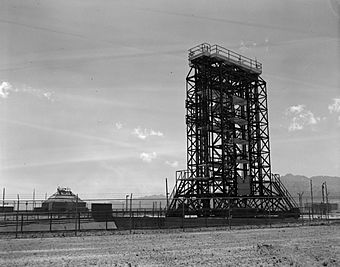White Sands V-2 Launching Site facts for kids
|
White Sands V-2 Launching Site
(Launch Complex 33) |
|

V-2 rocket facilities
|
|
| Location | White Sands Missile Range, New Mexico |
|---|---|
| Area | 10 acres (4.0 ha) |
| Built | 1945 |
| Built by | U.S. Army |
| NRHP reference No. | 85003541 |
Quick facts for kids Significant dates |
|
| Added to NRHP | October 3, 1985 |
| Designated NHL | October 3, 1985 |
The White Sands V-2 Launching Site is a special place in southern New Mexico. It's also called Launch Complex 33. This is where the United States first tested V-2 rockets. These rockets were captured from Germany at the end of World War II.
These tests were very important. They helped the military learn about rockets. They also started the journey toward the United States' space exploration programs. Because of its importance, this site became a National Historic Landmark in 1985.
Contents
Rocket History: The V-2 Story
The V-2 rocket was a very advanced weapon. It was built by Germany during World War II. Hundreds of these rockets were launched during the war. After the war, the United States started a secret program. It was called Operation Paperclip.
Operation Paperclip: Bringing Scientists to the USA
Through Operation Paperclip, American forces brought German scientists and engineers to the U.S. One famous scientist was Wernher von Braun. The U.S. also brought 100 captured V-2 rockets. These rockets came to the new White Sands Missile Range.
Early Rocket Launches: 1946-1951
Between 1946 and 1951, the U.S. Army launched 67 V-2 rockets from this site. These were called V-2 sounding rockets. They helped scientists learn a lot about how rockets fly. These early launches were key. They led to new rocket programs. Eventually, they helped send humans into space.
Exploring Launch Complex 33
Launch Complex 33 is at the southern end of the White Sands Missile Range. It covers about 10 acres (4 hectares). It is located east of the White Sands Range Museum. Two main structures from the launch complex are still there today.
The Launch Gantry: A Giant Steel Frame
One important part is the steel gantry. This is a tall steel structure. It is 75 feet (23 meters) high and 25 feet (7.6 meters) wide. Rockets like the V-2 were launched from here. The gantry has four platforms. These platforms can move. They can fit different sizes of rockets. It also has a system of ropes and pulleys. This helps move the rockets into place.
The Observation Tower: A Safe Viewpoint
The other main structure is a concrete observation tower. Its walls are very thick, about 10 feet (3 meters) thick. The roof is also very strong. It has 27 feet (8.2 meters) of solid concrete. This tower kept people safe during launches. It has special glass windows. These windows let people watch the rockets launch up close.



